Train station
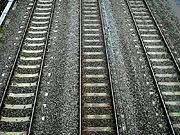 |
| Rail transport |
|---|
| Operations |
| Stations |
| Trains |
| Locomotives |
| Rolling stock |
| History |
| History by country |
| Terminology |
| By country |
| Accidents |
|
|
A train station, railway station, railroad station, or station yard is a facility at which passengers may board and alight from trains and/or rail-transported freight may be loaded or unloaded.[1] Historically, the term (railroad) depot has also been employed in North America.
A station usually consists of at least one building for passengers (and possibly freight) plus other installations associated with the functioning of the railway or railroad.[2] A small station with few facilities and/or limited use may be known as a "halt" in UK usage, or in US usage a "stop". "Train station" has only been in relatively recent usage in Great Britain and Australia, with the older term "Railway station" normally being used.
Early stations were sometimes built with both passenger and goods facilities; though a number of railway lines were goods only or passenger only, and if a line was dual purpose, there would often be a goods depot apart from the passenger station.[3] Dual purpose stations can sometimes still be found today, though in many cases goods facilities are restricted to major stations. Stations are sited either adjacent to a railway line, or at the end of one (in which case they are said to form the terminus of the line). Usually raised platforms are present to allow passengers to access trains easily and safely. Platforms may be connected by subways, footbridges, or level crossings; passenger facilities such as shelter, ticket sales and benches can be found on the platforms or (at larger stations, where buildings exist) in the station's public buildings.[4]
As well as providing services for passengers and loading facilities for goods, stations often had locomotive and rolling stock depots (which usually had facilities for storing and refuelling locomotives and rolling stock and carrying out minor repair jobs). In North America, a railway station that is jointly used by several rail transport companies is sometimes called a union station, or an interchange station. Stations co-located with other transport systems such as trams and buses may also be referred to as interchanges,[5] as may stations offering both metro/subway and heavy-rail services.
Contents |
Development
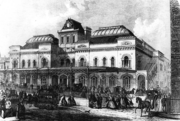
The first stations had little in the way of buildings or amenities. The first stations in the modern sense were on the Liverpool and Manchester Railway, opened in 1830.[6] As of 2008, Manchester's Liverpool Road Station is preserved as part of the Museum of Science and Industry in Manchester. It resembles a row of Georgian houses.
In rural and remote communities across Canada and the United States passengers wanting to board the train had to flag the train down in order for it to stop. Such stations were known as "Flag stops" or "Flag stations".[7]
Many stations date from the 19th century and reflect the grand scale architecture of the time, lending prestige to the city as well as to railway operations.[8] Countries where railways arrived later may still have such architecture, as later stations often imitated 19th century styles.

Various forms of architecture have been used in the construction of railway stations, from those boasting grand and intricate almost Baroque or Gothic-style edifices, to plainer utilitarian or modern styles. Stations in Europe followed British designs, and were in some countries, like Italy, financed by English railway companies.[9]
Stations built more recently, like Berlin's new Hauptbahnhof station, often have a similar feel to airports, with a simple abstract style. Examples of modern stations include those on newer high-speed rail networks, such as the Shinkansen in Japan, TGV lines in France or ICE lines in Germany.
Terminus

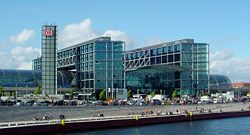

A terminus (or terminal, in North American parlance) is a station at which, since it lies at the very end of a line of railway, all arriving trains must perforce terminate their journeys, and from which they can consequently depart only following a reversal. The principal advantage of such an arrangement is that it permits travellers to reach all of the platforms without the need to cross any tracks – all of the main reception facilities and the public entrance to the station being accommodated at the far inbound end of the platforms. In a few cases, however, stations situated at the end of lines (and thus termini as far as the transport of passengers is concerned) are operationally through stations – "terminating" trains proceeding empty following arrival to a point beyond the station at which they reverse direction prior to returning to pick up departing passengers.
A terminus is frequently, but not always, the final destination of all trains arriving at the station. Where, however, the terminus is an intermediate point on a train's itinerary, arrangements must be made to allow the train to leave in the reverse direction from that of its arrival. There are several ways in which this can be accomplished:
- by detaching the locomotive which brought the train into the station and then either
- using another track to "run it around" to the other end of the train, to which it then re-attaches;
- attaching a second locomotive to the outward-bound end of the train; or
- arranging for the service to be provided by a multiple unit, or push-pull train, both of which are capable of operating in either direction. The operator simply walks the train and takes control of the other cab.
Also, an example of a terminal with this feature is Washington, DC's Union Station, where there are higher level platforms, Gates A through G serving the terminating trains, such as some Northeast Regionals and all Vermonters and Acela Expresses. Some other Northeast Regional trains and Atlantic Coast Service Trains use lower-level platforms, Gates H through L, with no I, that tunnel right under the concourse and continue to Florida or Virginia. Auto Train uses Lorton, Virginia Station for three primary reasons:
- The tri-level auto racks used to carry the cars are too tall to fit in the tunnels
- The platforms would be too short to accommodate the 30-60 coach trainset
- There's not enough room and there's too many tracks, trains, buildings and people around, therefore, loading cars would be quite tricky
It is common for a terminus to have a newer set of through platforms underneath the terminal platforms on the main level. They are used by a cross-city extension of the main line, normally for commuter trains, while the terminal platforms serve long-distance services. Examples of such lines include the Thameslink platforms at St. Pancras in London, the RER at the Gare du Nord in Paris and examples abound with S Bahn lines such as Zurich Hauptbahnhof.
The largest and most famous rail terminus in the United States is Grand Central Terminal in New York City, USA. Often major cities, such as London, Berlin, Boston, Paris, Tokyo, or Milan will have one or more termini, rather than routes straight through the city. Train journeys through such cities often require alternative transport (metro, bus or taxi) from one terminus to the other. Some cities, including New York, have both situations. Chicago has four major rail terminals presently in service, of which only one provides Amtrak intercity service (see Rail stations of Chicago).
Terminals that have competing rail lines using the station frequently set up a jointly owned terminal railroad to own and operate the station and its associated tracks, switching operations.
Station facilities
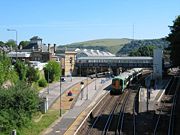
Railway stations usually include either ticket booths, or ticket machines. Ticket sales may also be combined with customer service desks or convenience stores. Many stations include some form of convenience store. Larger stations usually have fast-food or restaurant facilities. In some countries, such stations also have a bar, or pub. Other station facilities include: toilets, left-luggage, lost-and-found, departures and arrivals boards, luggage carts, waiting rooms, taxi ranks and bus bays. Larger or manned stations tend to have a greater range of facilities. A most basic station might only have platforms, though it would still be distinguished from a halt, a stopping or halting place that may not even have platforms. In many African and South American countries, stations are used as a place for public markets and other informal business. This is especially true on tourist routes or stations near tourist destinations as souvenirs can be made and sold to "wealthy" visitors to the county.
Configurations of railway stations
See also railway station layouts
In addition to the basic configuration of a railway station, various features set certain types of station apart. The first is the level of the tracks. Stations are often sited where a road crosses the railway: unless the crossing is a level crossing, the road and railway will be at different levels.

The platforms will often be raised or lowered relative to the station entrance: the station buildings may be on either level, or both. The other arrangement, where the station entrance and platforms are on the same level, is also common, but is perhaps rarer in urban areas, except when the station is a terminus. Elevated stations are more common, not including metro stations. Stations located at level crossings can be problematic if the train blocks the roadway while it stops, causing drivers to wait for an extended period of time.
An unusual configuration is where the station serves railway lines at differing levels. This may be due to the station's situation at a point where two lines cross (example: Berlin Hauptbahnhof), or may be to provide separate station capacity for two types of service, e.g. intercity and suburban (example: Paris Gare de Lyon or Philadelphia's 30th Street Station), or simply two different destinations.

Stations may also be classified on the layout of the platforms. Apart from single-track lines, the most basic arrangement is a pair of railway tracks for the two directions; but even there there is a basic choice of an island platform between, or two separate platforms outside, the tracks. With more tracks, the possibilities expand.
Some stations have unusual platform layouts, due to space constraints of the station location, or the alignment of the railway lines. Examples include staggered platforms, such as Tutbury and Hatton railway station on the Derby - Crewe line, and curved platforms, such as Cheadle Hulme railway station on the Macclesfield to Manchester Line. Triangular stations also exist where two lines form a three-way junction and platforms are built on all three sides.
Stops
During a journey, the term station stop may be used in announcements, to differentiate a halt during which passengers may alight, from a halt for another reason, such as a locomotive change.
A railway stop is a spot along a railway line, usually between stations or at a seldom-used station, where passengers can board and exit the train; US usage is flag stop.
While a junction or interlocking usually divides two or more railway lines or routes, and thus has remotely or locally operated signals, a station stop does not. A station stop usually does not have any other tracks than the main tracks, and no switches, although many exceptions exist where a station stop is within interlocking limits.
Halts
A halt, in railway parlance, is a small railway station, usually unstaffed and with few facilities. In some cases, trains only halt there "on request"; i.e. when a passenger on the platform indicates that they wish to board, or a passenger on the train informs the crew that they wish to alight.
In the United Kingdom most, if still in existence, have had the word halt removed from their title in recent years. Historically, in many instances the spelling 'halte' was used, before the modern spelling became commonplace. The only passenger station with the name halt still in use today is (on the station platform sign) Manchester United FC Halt, which only has a service on match days at Old Trafford Stadium.
Where the description is still used (orally, if not actually on the station signs) it is usually a station served by public services but not available for use by the general public, being accessible only by persons travelling to/from an associated factory (e.g. IBM Halt)(British Steel Redcar railway station), military base (e.g. Lympstone Commando) or railway yard. The only such station where the "halt" designation is still officially used is Hoo Junction Staff Halt on the North Kent Line, which is used by staff to access marshalling yards and is not open to passengers. The word is often used informally to describe stations with limited service and low usage, such as the Oxfordshire Halts on the Cotswold Line.
Accessibility
Accessibility for people with disabilities is important in station design and mandated by law in some countries. Considerations include: elevator or ramp access to all platforms, matching platform height to train floors, making wheelchair lifts available when platforms do not match vehicle floors, accessible toilets and pay phones, audible station announcements, safety measures such as tactile marking of platform edges.
Largest and busiest stations
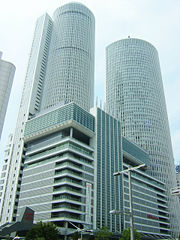
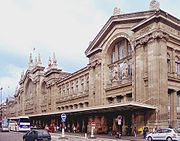
Worldwide
- The world's busiest station by passengers, in terms of daily passenger throughput, is Shinjuku Station in Tokyo, Japan.[10]
- Ikebukuro Station, just minutes away, is the world's second-busiest.
- The world's largest station by floor area, is Nagoya Station in Nagoya, Japan.[11]
- However, the Nagoya Station complex incorporates two office towers and an underground shopping concourse, so the railway terminal itself is not large in comparison to others. Its title of world's largest station complex building will be soon lost to London Bridge.
- Shinjuku Station is the second largest.
- In terms of platform capacity, the world's largest station by platforms is Grand Central Terminal in New York City USA with 67 platforms, although such a high amount is not needed due a reduction of services after its heyday.
- The Gare du Nord, in Paris is the second largest with 42 platforms.
Europe
- The Gare du Nord, in Paris, is the world's third-busiest and Europe's busiest by passengers and largest by platforms'.
- Clapham Junction, in south London, is the busiest by rail traffic with 117 trains per hour off-peak (one train every 13 seconds at peak times).
- Zurich Hauptbahnhof is the busiest terminus by rail traffic.
- In Europe, the largest station by floor area is Leipzig Hauptbahnhof with 24 platforms and several levels of shopping facilities beneath.
North America
- Penn Station in New York City is the busiest station in North America.[12][13]
Other Records
- Coney Island-Stillwell Avenue in New York City is the world's largest elevated terminal with 8 tracks and 4 island platforms.
- The Shanghai South Railway Station, opened in June 2006, has the world's largest circular transparent roof.[14]
- Châtelet-Les Halles, in the centre of Paris, is the world's largest underground station.[15]
Gallery
See also
|
|
References
- ↑ "Bishopsgate Goods Station (Goodsyard)". Subterranea Britannica (2005-06-29). Retrieved on 2008-03-13.
- ↑ "Romance of a Station". Mike's Railway History (December 2007). Retrieved on 2008-03-13.
- ↑ "The Inception of the English Railway Station". Architectural History 4: pp. 63–76. 1961. doi:. http://links.jstor.org/sici?sici=0066-622X(1961)4%3C63%3ATIOTER%3E2.0.CO%3B2-Q. Retrieved on 2008-03-13.
- ↑ "NS Station Furniture". Benelux Railways Society. Retrieved on 2008-03-13.
- ↑ "Chorley Interchange". Lancashire County Council (2008). Retrieved on 2008-03-13.
- ↑ Moss, John (2007-03-05). "Manchester Railway Stations". Manchester UK. Papillon. Retrieved on 2008-03-13.
- ↑ "Stations of the Gatineau Railway". Historical Society of the Gatineau. Retrieved on 2006-05-11.
- ↑ Miserez, Marc-André (2004-06-02). "Stations were gateways to the world", SwissInfo. Retrieved on 2008-03-13.
- ↑ "Italian Railroad Stations". History of Railroad Stations. Retrieved on 2008-03-13.
- ↑ "Machines & Engineering: Building the Biggest". Discovery Channel (2008). Retrieved on 2008-03-13.
- ↑ "Nagoya Station". Japanese Lifestyle (2007-12-17). Retrieved on 2008-03-13.
- ↑ Empire State Development (2007-10-23). "State begins public review for new Moynihan Station". Press release. Retrieved on 2008-02-12.
- ↑ Jackson, Kenneth T., ed.. Encyclopedia of New York City,. pp. p. 891.
- ↑ "The railway station with world's largest transparent roof", People's Daily (2006-06-26). Retrieved on 2008-03-13.
- ↑ "Un pôle de transport d'envergure régional" (PDF) (in French). RATP. Retrieved on 2008-03-13.
External links
- A comprehensive technical article about stations from Railway Technical Web Pages
- Branch Line Britain gives details of many railway stations throughout Britain
|
||||||||||||||||||||||||||
